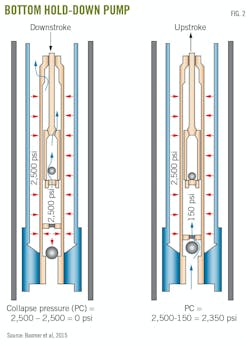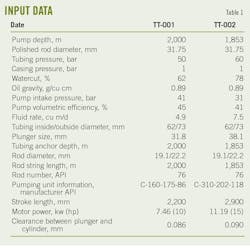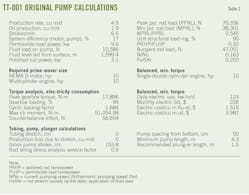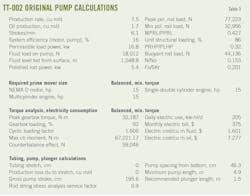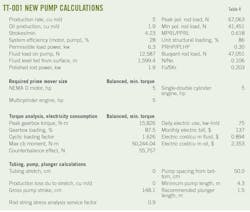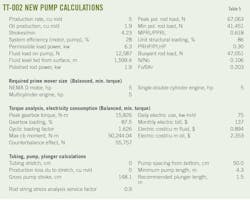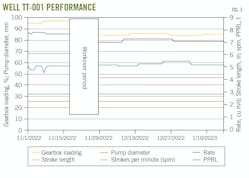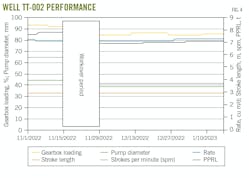Milos Petrovic
Bojan Martinovic
Milica Jesic
NIS-Naftagas Ltd.
Novi Sad, Serbia
Miroslav Crnogorac
University of Belgrade
Belgrade, Serbia
Traditional sucker rod pumps (SRP) use a single traveling valve, but recent double traveling valve innovations have improved SRP performance and efficiency in field applications with double traveling valves installed in pumps with top mechanical seating. The valves sealed better and produced similar fluid volumes compared with the previous single-valve pumps. They also enabled a reduction in pump diameter and optimized usage of surface equipment. Overall, the double travel valve SRPs produced stable production rates and annual production targets.
SRP efficiency
The reciprocal movement of rods in SRPs creates a piston-like action that draws fluid from the wellbore and lifts it to surface.1 2 These pumps are typically driven by a surface-mounted prime mover, such as an electric motor or diesel engine, which imparts the required mechanical energy to the system.3
SRPs suffer from low efficiency, rod fatigue, corrosion, and poor fluid dynamics. Optimized SRP pump designs and operational practices ensure reliable and efficient production in increasingly complicated oil and gas reservoirs, including unconventional formations with high water cuts, heavy oil, or gas condensates.4 Byrd et al. addressed these concerns by proposing a performance effectiveness rating system from a complex formula which requires optimization tables containing operational parameters for pumping cycles.5
Stroke efficiency is maximized by diminishing the ratio of the traveling- and standing-valve clearance volume to the volume swept out by the pump plunger. The traveling valve, inside the pump barrel, is responsible for controlling the flow of fluid during the upstroke and downstroke of the pump.6 This one-way valve design ensures efficient production by maximizing fluid discharge while minimizing fluid loss.7
During the up stroke, any portion of the pump cylinder traversed by the plunger occupied by the expanded fluid represents a loss of efficiency in the pump. The higher the compression ratio, the higher the volume of fluid compressed and stocked into the cylinder, resulting in lower pump system efficiency. This problem occurs when there is compressible fluid (gas) in the pumping system. An actuated traveling valve assembly designed to achieve minimum discharge pressure enables the lighter fluid to be pumped out-of-cylinder, increasing efficiency.8
In contrast to problems with lighter fluids in the barrel, rod strings also have difficulties handling heavy and viscous oils. On Boscan field, Venezuela, many wells with SRPs had restarting problems after interruptions of 2 or more days due to the high forces required to overcome static friction associated with high-viscosity oil. This problem was resolved by using a downhole stuffing box production scheme.9
Traditional SRP’s pumps typically use a single traveling valve, but recent innovations have introduced a double traveling valve system to address these issues and optimize pump performance and efficiency.
Pump-valve action
Once the plunger reaches its lowest point during the beginning of upward motion, the traveling valve closes due to high hydrostatic pressure in the tubing above it. This closure lifts liquid to the surface in the tubing above the traveling valve as the plunger moves upward. Simultaneously, pressure decreases in the area between standing and traveling valves opens the standing valve. Wellbore pressure drives formation liquid through the standing valve and into the barrel below the plunger. This lifting-and-filling process continues until the upstroke is complete.
Throughout the upstroke, the plunger and connected rod-string bear the entire weight of the liquid column in the tubing string. This substantial pulling force causes the rod-string to stretch due to its elasticity. Once the plunger reaches the top of its stroke, the rod-string starts moving downward, initiating the downstroke. The traveling valve promptly opens, and the standing valve closes. These valve operations occur because the liquid in the barrel is incompressible.
Tubing stretch occurs when the traveling valve opens and transfers liquid weight from the plunger to the standing valve. During downstroke, the plunger descends inside the barrel filled with formation liquid while the traveling valve remains open. When the downstroke is complete, the direction of the rod string’s movement reverses, and another pumping cycle begins. The weight of the liquid is once again transferred to the plunger, causing rods to stretch while returning the tubing to its original state.10
The pressure difference across the pump barrel wall and plunger during the plunger stroke creates axial and radial loading, and these pressures vary depending on pump type and landing mode. These loads play a crucial role in determining maximum allowable pump-setting depth based on fatigue strength of the pump material. Radial loading can be categorized as either burst or collapse, depending on factors such as the plunger’s motion direction and position, as well as the hold-down location. Pumps have either top or bottom mechanical seating, and Figs. 1-2 show pressure relations during pumping with these seatings.
Double traveling valves
The double traveling valve system installs two traveling valves in a single sucker rod pump for more precise control over the fluid flow and enhanced pump efficiency.11 Double traveling valves offer the following advantages:
- Increased efficiency. Double traveling valves can enhance the efficiency of the pump system by reducing fluid slippage during the upstroke.
- Enhanced fluid control. Double traveling valves provide better control over fluid flow and production rates. With two valves in series, operators can adjust the valves independently to optimize flow rates based on well conditions and reservoir characteristics.
- Increased reliability. Two traveling valves can enhance the reliability and longevity of the pump system. If one valve fails or requires maintenance, the second valve can continue to function, minimizing downtime and production disruptions.
- Versatility. Double traveling valves offer versatility in various operating conditions. They can be advantageous in wells with high gas-to-liquid ratios or in which the fluid properties, such as viscosity or corrosiveness, vary significantly.
This system can reduce wear on moving parts of the crank mechanism and reduce loads on the gearbox and crank mechanism. It provides safer operation of the crank and requires lower power for the electric motor.
Double traveling valves may require additional upfront costs, complexity in installation, and maintenance. The decision to utilize double traveling valves should consider factors such as well characteristics, production requirements and expertise available for installation and maintenance as part of an overall cost-benefit analysis.
Field implementation
A double valve SRP field test on oil field T required an initial analysis of existing equipment on candidate wells. All wells were equipped with downhole sucker rod pumps with either top or bottom mechanical seating, a 0.1270-0.0762 mm clearance range between plunger and cylinder, and a single traveling valve. Modified test pumps with double traveling valves used top mechanical seating because pumps with bottom mechanical seating already had high efficiency and would not benefit as much from the double valve. In addition to increased efficiency in the operation of the downhole pumping system, a double traveling valve with top mechanical seating optimizes pump parameters for deviated wells and enables a smaller pump diameter, optimizing surface equipment.
Table 1 lists all necessary input data for pump calculations. Tables 2-3 show calculated parameters using RODSTAR software for wells TT-001 and TT-002 before installing the double traveling valves.
For the double valve retrofits, new calculations were performed on selected oil field T well candidates using the same input data and software as the single-valve baseline studies but with an increased double traveling valve efficiency coefficient in the pump’s technical characteristics. The double traveling valve produced the best pump performance efficiency for wells TT-001 and TT-002 compared with the currently installed pumps (Tables 4-5).
When purchasing equipment for the modified downhole sucker rod pumps, several seats and balls for the traveling valve were specifically ordered for testing in wells in combination with all the other equipment available in the company’s warehouses at that time. Pumps with modified technical characteristics, in addition to the double traveling valves, were also installed during well repairs. Measured data matched calculated results using all updated well parameters.
Based on the analysis of the production data from wells TT-001 and TT-002, a well production history report encompassing production parameters and operating parameters of the SRP system shows a decrease in the number of strokes, indicating a potential improvement in pump efficiency (Figs. 3-4). The analysis also highlights a decrease in gearbox loading, which suggests a reduction in the mechanical stress endured by the pump’s transmission system.
References
- Boomer, P.M. and Podio, A.L., “The Beam Lift Handbook,” The University of Texas at Austin Petroleum Extension, 2015.
- Bello, O., Dolberg, E., Teodoriu, C., Karami, H., and Devegowdva, D., “Transformation of academic teaching and research: Development of a highly automated experimental sucker rod pumping unit,” Journal of Petroleum Science and Engineering, Vol. 190, July 1, 2020, p.107087
- Xing, M., “Response analysis of longitudinal vibration of sucker rod string considering rod buckling,” Advances in Engineering Software, Vol. 99, September 2016, pp. 49-58.
- Naderi, A., Ghayyem M.A., and Ashrafi, M., “Artificial Lift Selection in the Khesht Field,” Petroleum Science and Technology, Vol. 32, May 19, 2014, pp. 1791-1799.
- Byrd, J.P. and Hale, L.A., “The Influence of the Rod-Coupling-Piston Effect on the Rod Load of a Sucker-Rod Pumping System,” Spring meeting of the Rocky Mountain District, API Division of Production, 1970.
- Guo, B., Liu, X., and Tan, X., “Sucker Rod Pumping,” Petroleum Production Engineering, Elsevier Inc., 2017, pp. 515–548.
- Boyuan, Z., Xianwen, G., and Xiangyu, L., “Diagnosis of Sucker Rod Pump based on generating dynamometer cards,” Journal of Process Control, Vol. 77, May 2019, pp. 76-88.
- Gala, R.D. and Priyyamvada, K., “Preventing Gas Locking in Sucker Rod Pumps using an Actuated Traveling Solenoid Valve,” SPE 165039, SPE Artificial Lift Conference-Americas, Cartagena, Colombia, May 21-22, 2013.
- Guirados, C., Sandoval, J., Rivas, O. and Troconis, H., “Production Optimization of Sucker Rod Pumping Wells Producing Viscous Oil in Boscan Field, Venezuela,” SPE 29536, SPE Production Operations Symposium, Oklahoma City, Okla., April 2-4, 1995.
- Gabor, T., “Sucker – Rod Pumping Handbook: Production Engineering Fundamentals and Long-Stroke Rod Pumping,” Gulf Professional Publishing, Oxford, UK, 2015.
- Hopf M., “Alternative Valve Design for SRP Pumps,” Montanuniversität Leoben, Austria, 2017.
The Authors
Milos Petrovic is an oil and gas production technology engineer at Naftna Industrija Srbije (NIS) JSC. He holds an MS (2019) in petroleum engineering from the University of Belgrade.
Bojan Martinovic ([email protected]) is head of production technology at Naftna Industrija Srbije (NIS) JSC. He holds an MS (2012) in petroleum engineering from the University of Belgrade, Serbia, where he is completing his PhD studies.
Milica Ješic´ ([email protected]) is lead engineer, oil and gas production analytics, at Naftna Industrija Srbije (NIS) JSC, Serbia. She holds an BS (2019) in petroleum engineering from the Mining University of Saint-Petersburg, Russia, and an MS (2023) from the University of Belgrade, Serbia.
Miroslav Crnogorac ([email protected]) is an assistant professor at the University of Belgrade. He holds a PhD (2020) in petroleum engineering from University of Belgrade. He is a member of Society of Petroleum Engineers and Union of Engineers and Technicians of Serbia.

